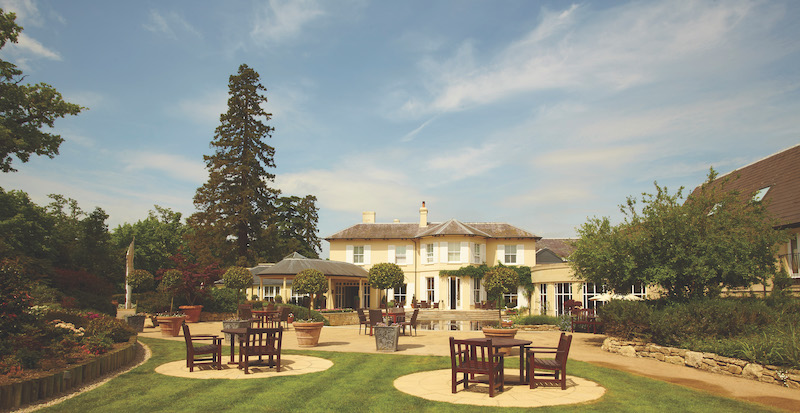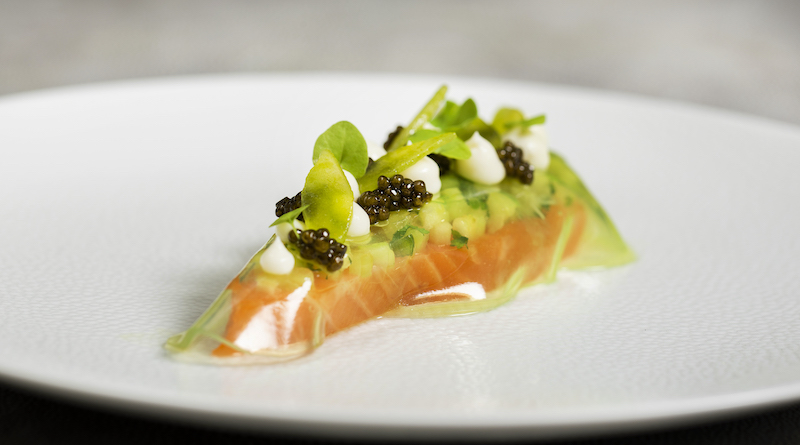
This article is in a series designed to provide an alternative to ‘A N Other’ opinion about a chef’s output, to be lost in the now sea of increasing noise about top end dining. This is something slightly different. In this feature, Tom Scade of The Vineyard Hotel, near Newbury, will analyse dishes against the five criteria used by Michelin for awarding a Michelin star. How so? At The Michelin Guide GB&I launch event for the 2018 Guides, a slide was briefly discussed by Michael Ellis (then WW Director of Michelin Guides), which for the first time highlighted the five criteria followed by inspectors in the awarding of Michelin Stars. Michael Ellis confirmed these under interview on that day, as a reminder he explained:-
“The first and most important criteria is the ingredients, all great cuisine starts with great product – the actual product itself is considered for freshness, quality, flavour and texture and so on. The second criteria is mastery of cooking technique. The third criteria is equilibrium and harmony in flavours; the plate must be in balance, so the sauce is not, for example, overpowering the flavour of the fish or that the seasoning of the dish is found to be exactly as it should be. The fourth criteria is regularity (or consistency) and this means starter, main and dessert are all of the appropriate standard and that each are also consistent over time. Finally, value for money is the fifth criteria.”
The Michelin Guide UK newsletter in autumn 2022 gave an update to these criteria. Value for money no longer appeared and was replaced by ‘the personality of the chef as expressed through their cuisine.’ One might argue that this new measure is significantly more subjective that the other four, meaning that any attempt to objectively quantify the success or otherwise of the chef in attempting to achieve a Michelin Star, will always reside with the interpretation of the inspectors of The Michelin Guide.

At the tender age of 16, Tom Scade won a scholarship to Royal Academy of Culinary Arts apprenticeship training in Bournemouth. His placement saw him travel to London to work for Keith Stanley at Langan’s Coq d’Or, where he remained for the following three and a half years. Tom gained invaluable experience across all the sections. To this day, he remains a firm believer that it takes a year simply to learn how to work in a professional kitchen. Ideally, this should be followed by annual promotion across each of the sections, thus enabling a new challenge and a short term, but necessary, discomfort in order to learn and improve skillsets.
Tom’s personal gastronomic journey of learning, took in every aspect of hospitality, from working pubs where he saw all sides of the business, right through to the greatest of hotel restaurant kitchen institutions (The Ritz). This was complemented by a spell working for a multi-Michelin starred inspirational chef in Martin Blunos. In 2018, Tom was recognised as the winner of Le Taittinger Prix Culinaire before coming third in the world finals later that year. Since June 2019, he has been in his current role at The Vineyard Hotel.

Tom is essentially engaged to deliver one of owner Sir Peter Michael’s passions, that is the marriage of fine wine with the art of gastronomy. Sir Peter, who was the founder of Classic FM, is a lover of wine, food, music, art and good company. He acquired The Vineyard Hotel property in 1996, launching under its current guise in 1998. Beautiful pieces of art and sculpture from Sir Peter’s private collection feature around the hotel, alongside a visually stunning cellar stocked with premium wines, many of which have come from Sir Peter’s own vineyards in California.
Tom Scade sees the kitchen as progressive, having had the requisite time to stamp his way of doing things, he notes, “With each passing six months the food is that much better, with consistency the mantra!” As we turn to those five Michelin criteria against Tom’s chosen dishes, consistency is a key criterion. In fact, the practices and procedures employed facilitate regularity both across the menu and over time. As well as the ubiquitous, precise recipe books, Tom sees the importance of the intensity of the kitchen team working through the morning, ensuring a relatively smooth and peaceful lunch service. Simply speaking, everything that is prepared is brought together. “It is this way because too much cooking à la minute can lead to inconsistency,” explains Tom. “Proper pre-planning leads to confident repetitive execution,” he adds. The Vineyard’s relationships with suppliers are also fundamental to consistency across the menu and over time as they enjoy the same size, quality and freshness of product on an ongoing basis. A colleague at The Ritz (Premier Sous Chef, Deepak Mallya) instilled the need for detail in recipes to ensure the precise end product was achieved time and again (from each stock produced to the exact number of peppercorns in a sauce). Having the experience to have learned from your mistakes is also vital – “If young Jonny behind me has split the hollandaise it wouldn’t matter because I have split a hollandaise plenty of times and know how to correct it.” In this way there are no panics and the kitchen always retains its focus.

Tom believes that a chef must express their personality on a plate, as it is fundamental to the chef’s career satisfaction. “I couldn’t imagine going through the motions and painting by numbers,” says Tom. He cites Martin Blunos, as having moved to Bristol and for a short while continued to produce what had been offered at a London kitchen. He duly gained a Michelin Star. It was only after he had a cooking epiphany and cooked from the heart – including his Latvian roots – that the second Michelin Star arrived. This explanation fits with what then Michelin Guides editor, Derek Bulmer, described at interview in 2005: Namely that a protégé of (say Gordon Ramsay) could gain one star accurately reflecting Gordon Ramsay’s signature, to achieve a second would require their personal signature in the cooking.
Customers may also witness menus, including tasting menus, where there is no common theme, signature or personality. Indeed, it may appear that the output may be from three different chefs. In this case, perhaps there has been poor harnessing of kitchen talent, neglecting to mould menu proposals into the “house signature.” Alternatively, the chef has reproduced some dishes that were created by other chefs, which he had encountered earlier in his working life. Neither will go down well with Michelin according to their own criteria. The over-riding personality of the Vineyard kitchen is California influenced with a local, fresh produce orientation. Sir Peter Michael’s wine may also lead the scope for dish creation, sparking spontaneous ideas for flavours on a plate, with precise, clean understated dishes. Tom is classically trained and there’s no escape from that at The Vineyard – “proper cooking” – A bouillon tastes amazing with the right mouth feel, because it has calves’ feet rather than a gelatine based shortcut. This typifies the way Tom avoids too many chemicals and takes the classical route to true mouth feels and flavours.

The first dish is the trout dish, which has been on the menu since day one, currently locally sourced River Kennet trout, from Berkshire Fish. They are more focused on angling and less on the commercial catering side. For this reason, the kitchen gets the pick of the trout and sometimes they are so fresh they must be kept for a day. Cucumber, horseradish and Caviar are the classic flavours that shine through with this dish. The fish is cured in “California sunshine,” including lemon verbena, grapefruit, sumac and so on. It is lightly cooked and sliced, served with horseradish (grated and purée’d), diced apple and a covered in a veil of cucumber jelly. This is finished with oscietra Caviar sourced through Laura King. The processes and combinations elevate a humble fish into a clean, precise and delicious dish.
The second dish is the venison, which is locally sourced from Yattendon. Vickers Game is ten miles from The Vineyard and Tom works closely with their butcher. The best way to cook the loin of venison is to simply pan roast with plenty of foaming butter and aromats, before being sliced and served with turnips and cèpes. The trimmings are cooked down with brown butter creating a caramelised purée. On the side is a mushroom mash; mushroom trimmings from throughout the day are roasted down and infused with cream, the mash is topped with preserved elderberries that have been hand-picked and enhanced by venison jus. The accompanying red wine sauce is an homage to John William (Ritz), “if I couldn’t cook a good red wine sauce there’d be a problem,” smiles Tom.

The front of house is well served with efficient, knowledgeable but unobtrusive staff who also understand the imperative of gentle conversation with an engaging smile. Consistency across the whole hotel food and beverage operation is a mantra, highlighted by the customer food and service experience in the main dining room. The Vineyard remains a self-described wine-led hotel. The cellar boasts 30,000 bottles which are ably managed by Head Sommelier, Romain Bourger, once a winner of UK Sommelier of The Year and now proudly invited to be a judge of that competition.

Tom’s ambition is to drive forward The Vineyard Hotel’s gastronomic offering in the context of the hotel strategy. The onset of lockdowns through Covid, led to a rethink of the hotel dining concepts with the construction of a spectacular outdoor marquee that allowed guest dining through difficult times. The offering was more informal and relaxed with attendance numbers impressively exceeding expectations. The success of this improvisation will likely see its return in summer 2023. At the same time, the hospitality industry’s move toward informality has seen the creation of ‘The Vine Bar’ lunch offering of small plates to be shared with beautiful wines. This too, has proved an inspired step forward. The culinary focus, however, remains the top-end dining offering in the main restaurant. The evidence of the meal at The Vineyard, enhanced by interviews with Tom, demonstrates a chef with a great touch, a mastery of classical technique and an eye to relevance in the present and future



